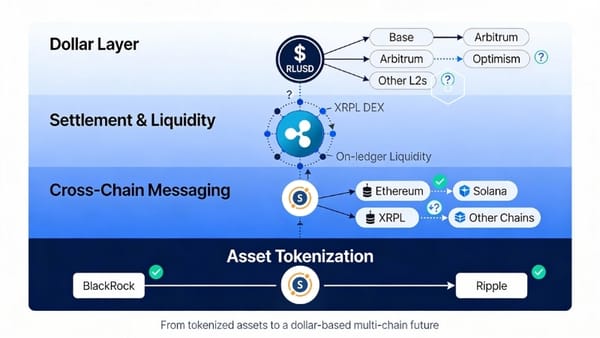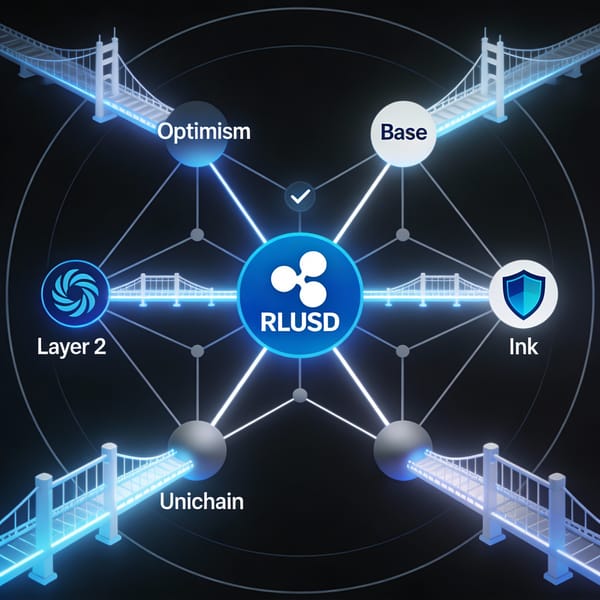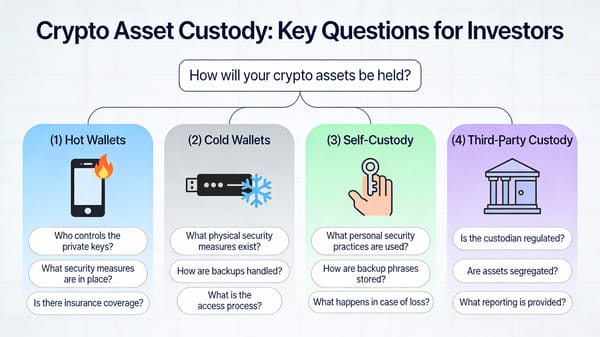Ripple-Chainlink Partnership: Infrastructure Alignment Drives DeFi Innovation
Ripple adopts Chainlink data standard for RLUSD as US government validates oracle infrastructure for GDP delivery. Strategic alignment between liquidity and data layers signals shift toward integrated blockchain infrastructure for institutional adoption.

The convergence of blockchain infrastructure has reached a pivotal moment as Ripple adopts Chainlink's data standard for its RLUSD stablecoin, while the U.S. government selects Chainlink to deliver official macroeconomic data on-chain. This strategic alignment between liquidity and data layers signals a fundamental shift toward integrated blockchain infrastructure.
[THREAD]: XRP Ledger vs Chainlink.
— RippleXity (@RippleXity) August 28, 2025
Why did the U.S. government choose Chainlink over the XRP Ledger to bring economic data on-chain?
This decision actually strengthens Ripple’s vision.
Let’s break it down👇🧵 pic.twitter.com/nDB8CkcsBO
Partnership Overview: Complementary Strengths Unite
Ripple announced on January 7, 2025, that it has officially adopted Chainlink's data standard to provide high-quality pricing data for its RLUSD stablecoin across DeFi applications. The integration enables Chainlink Price Feeds to deliver secure, reliable RLUSD pricing data on Ethereum mainnet, allowing developers to integrate support for RLUSD into trading, lending, and other financial applications.
"As RLUSD scales across DeFi ecosystems, reliable and transparent pricing is essential to maintaining stability and building trust in its utility within decentralized markets," said Jack McDonald, Senior Vice President of Stablecoin at Ripple. "By leveraging the Chainlink standard, we bring trusted data on-chain, further strengthening RLUSD's utility across both institutional and decentralized applications."
The partnership addresses a critical infrastructure gap. While RLUSD launched in December 2024 with a current market capitalization of approximately $77 million, DeFi applications require reliable pricing data to manage risks associated with stablecoin operations. Chainlink's Price Feeds source data from numerous premium data aggregators, creating price information that's aggregated from hundreds of exchanges, weighted by volume, and cleaned of outliers and wash trading.
Government Validation: Why Chainlink Was Chosen
The U.S. Department of Commerce's selection of Chainlink to deliver official macroeconomic data on-chain provides crucial context for understanding the infrastructure landscape. On August 28, 2025, the Commerce Department announced it would publish GDP data and other key economic indicators across nine blockchain networks using Chainlink's oracle infrastructure.
Commerce Secretary Howard Lutnick emphasized the significance: "It's only fitting that the Commerce Department and President Donald Trump, the Crypto-President, publicly release economic statistical data on the blockchain." The initiative brings Real Gross Domestic Product (GDP), Personal Consumption Expenditures (PCE) Price Index, and Real Final Sales to Private Domestic Purchasers on-chain through Chainlink Data Feeds.
This government endorsement validates Chainlink's role as the premier oracle solution for mission-critical data delivery. The infrastructure that enables over $18 trillion in transaction value now serves as the bridge between traditional economic data and blockchain applications, demonstrating chain-agnostic functionality that XRPL, as a payment-focused network, cannot directly provide.
Market Implications: Infrastructure Convergence
The Ripple-Chainlink alignment represents broader market recognition that successful blockchain adoption requires specialized infrastructure working in concert rather than competing. Chainlink's LINK token surged over 5% following the Commerce Department announcement, while the broader implications extend beyond immediate price movements.
Major DeFi protocols are already incorporating RLUSD using Chainlink-powered data feeds. Aave, one of the largest lending protocols, has begun integrating RLUSD into its ecosystem, validating the utility of this infrastructure combination. This adoption pattern suggests that the Chainlink standard is becoming essential infrastructure for stablecoin integration across DeFi.
The government's choice of Chainlink for economic data distribution also highlights the oracle network's unique position. Unlike payment-focused networks like XRPL, Chainlink specializes in delivering external data to blockchains—a function that becomes increasingly critical as traditional institutions seek to interact with decentralized systems.
Regulatory and Legal Considerations
The partnership emerges during a favorable regulatory environment for crypto innovation. The Trump administration's pro-crypto stance has accelerated blockchain adoption across federal agencies, with the Commerce Department leading by example. This regulatory support provides a foundation for broader institutional adoption of blockchain-based financial infrastructure.
For Ripple, the Chainlink integration represents strategic positioning beyond its ongoing legal challenges. While RLUSD operates independently of XRP's regulatory status, the stablecoin's success through established infrastructure partnerships demonstrates Ripple's ability to execute in compliant markets.
The use of ISO 27001 certified and SOC 2 Type 1 attested Chainlink infrastructure provides institutional-grade security standards that regulatory bodies increasingly expect from blockchain applications handling financial data.
XRP and Ripple Impact Analysis
Price Potential and Market Position
The infrastructure alignment strategy positions XRP within a broader ecosystem approach rather than as a standalone solution. While RLUSD operates on both XRPL and Ethereum, its success through Chainlink integration could drive increased attention to XRPL's utility for settlement and tokenization use cases.
The $77 million RLUSD market cap, while modest compared to established stablecoins like USDT and USDC, represents early-stage adoption that could accelerate through reliable data infrastructure. As DeFi applications gain confidence in RLUSD pricing through Chainlink feeds, demand for the stablecoin could increase, potentially benefiting the broader Ripple ecosystem.
Business Operations Enhancement
Ripple's strategy demonstrates recognition that blockchain success requires ecosystem integration rather than vertical silos. By adopting Chainlink's industry standard, Ripple gains access to the oracle network's extensive DeFi integrations and institutional relationships.
This approach could accelerate RLUSD adoption among Ripple's existing financial institution partners while opening new channels through Chainlink's ecosystem of over 2,400 integrations. The combination of Ripple's payment infrastructure expertise and Chainlink's data delivery capabilities creates compelling value propositions for enterprise clients.
Partnership Opportunities
The Chainlink relationship validates Ripple's interoperability strategy. As David Schwartz has emphasized, mass adoption requires blockchain networks to work together rather than compete in isolation. The RLUSD-Chainlink integration exemplifies this philosophy in practice.
Future partnership opportunities could extend beyond stablecoin pricing to include cross-chain liquidity solutions, where Chainlink's data feeds inform XRPL-based settlement mechanisms. This infrastructure combination could address enterprise needs for both real-time payment rails and reliable market data.
Adoption Prospects
The government's endorsement of Chainlink for economic data distribution creates a precedent that could influence private sector adoption decisions. As institutions increasingly recognize blockchain infrastructure's reliability for mission-critical applications, Ripple's alignment with established standards positions XRPL favorably for institutional adoption.
The success of RLUSD through Chainlink integration could also demonstrate XRPL's capability to support sophisticated financial applications, potentially attracting developers and institutions to build on the network beyond payment use cases.
Conclusion
The Ripple-Chainlink partnership represents strategic infrastructure alignment rather than mere technical integration. As the U.S. government validates Chainlink's data delivery capabilities and DeFi protocols adopt RLUSD through reliable pricing feeds, this collaboration demonstrates how specialized blockchain infrastructure can work together to serve institutional and retail needs.
For the broader crypto ecosystem, this partnership signals maturation toward interoperable infrastructure where payment rails, data oracles, and settlement networks complement rather than compete with each other. The success of this model could accelerate institutional adoption while providing a blueprint for sustainable blockchain ecosystem development.
The key insight is clear: blockchain adoption succeeds through infrastructure convergence, not competition. Ripple's recognition of this principle through Chainlink adoption positions both RLUSD and the broader XRP ecosystem for sustainable growth in an increasingly interconnected digital asset landscape.
DISCLAIMER: This newsletter is for informational purposes only and does not constitute investment advice, advertising, or a recommendation to buy, sell, or hold any securities. This content is not sponsored by or affiliated with Uphold, XRP, or any mentioned entities. Investments in cryptocurrencies or other financial assets carry significant risks, including the potential for total loss, extreme volatility, and regulatory uncertainty. Past performance is not indicative of future results. Always consult a qualified financial professional and conduct thorough research before making any investment decisions.
Sources
- Ripple Official Press Release: Ripple Adopts The Chainlink Standard To Further Ripple USD (RLUSD) Utility and Access in DeFi
- PYMNTS.com: Ripple Adopts Chainlink Standard for Better Stablecoin Pricing Data - January 7, 2025
- CoinDesk: LINK, PYTH News: Chainlink and Pyth Selected to Deliver U.S. Economic Data On-Chain - August 28, 2025
- Chainlink Official Blog: U.S. Department of Commerce and Chainlink Bring Economic Data Onchain - August 28, 2025
- Bloomberg: US Puts GDP Data on the Blockchain in Trump Crypto Push - August 28, 2025
- CryptoSlate: Ripple partners with Chainlink to enhance RLUSD stablecoin with secure data feeds - January 7, 2025
- @RippleXity Twitter Thread: Referenced analysis on XRP Ledger and Chainlink complementary functions



